So you want to buy a watch but you have no idea where to start. It’s ok, there are a lot of men’s watch styles out there.
Learning about watches and trying to make the right purchase decision can be complete information overload. Don’t be the guy who impulse-buys a watch only to experience buyer’s remorse though.
In this article, we show you the 10 watches every guy should know. What can you expect us to cover? Here’s a summary of the men’s watch styles covered in this article.
They are:
Men’s Watch Style #1 Pocket Watch
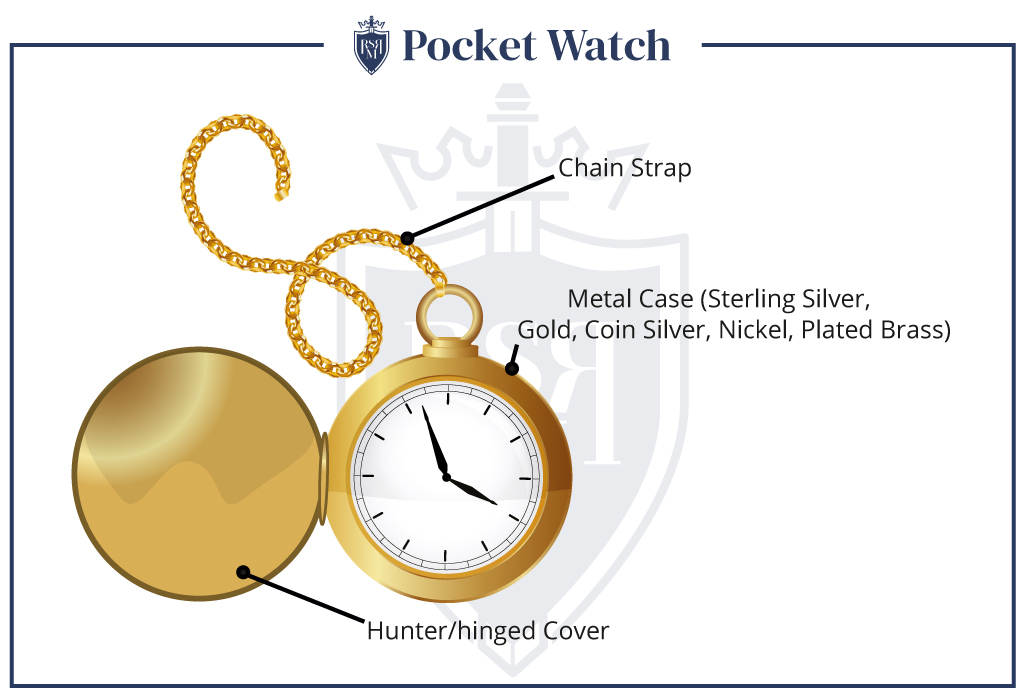 The original portable clock!
The original portable clock!
When you think of a pocket watch, you probably picture wealthy Victorian aristocrats smoking pipes and wearing monocles. You’re not too far off the mark!
The first pocket watches are said to have been manufactured in 1675 when King Charles II of England introduced vests as a menswear staple.
The vest became a practical place to store watches in order to protect them from the weather. Before then, watches were worn around the neck!
What to look for in a Pocket Watch
- Secured to a vest or waistcoat using a metal chain or leather strap. This system prevents the watch from being dropped or stolen.
- Chains are often decorated in silver or colored enamel.
- Watch decorations include coats of arms and sigils for clubs or societies.
- Watch casing is mostly constructed from metal but rarer watches have ceramic and even glass cases.
Pocket watches generally fall into 2 categories:
Men’s Watch Style #2 Railroad Watch
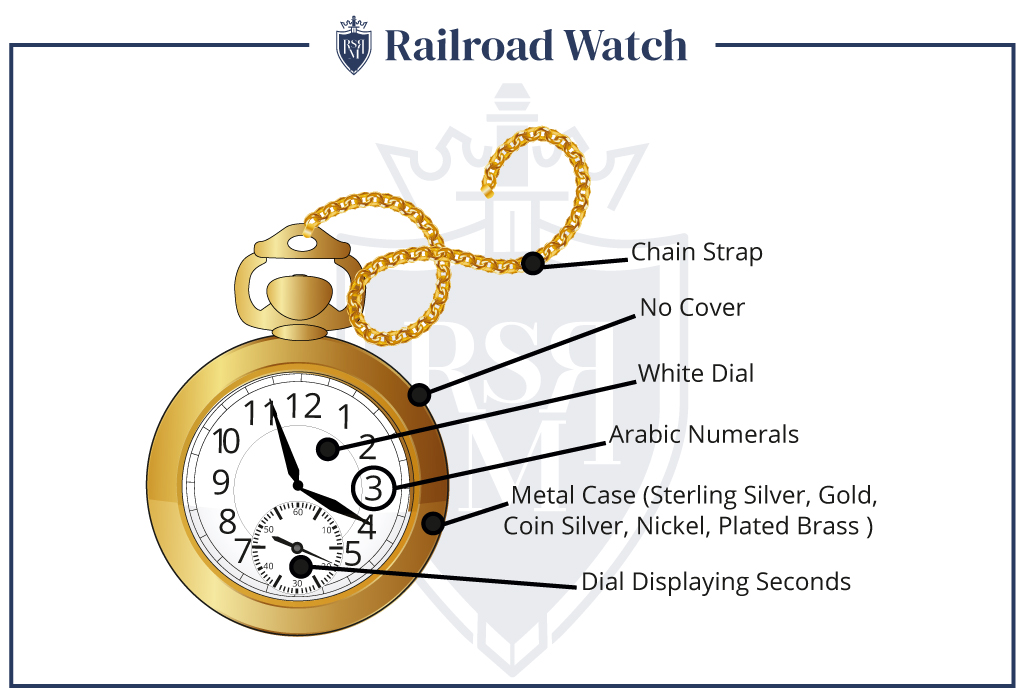 The Railroad Watch is an iconic American watch style.
The Railroad Watch is an iconic American watch style.
Pocket watches evolved quickly after 1891 following The Great Kipton TrainDisaster – a catastrophic train crash that occurred on the Lake Shore and Southern Railways.
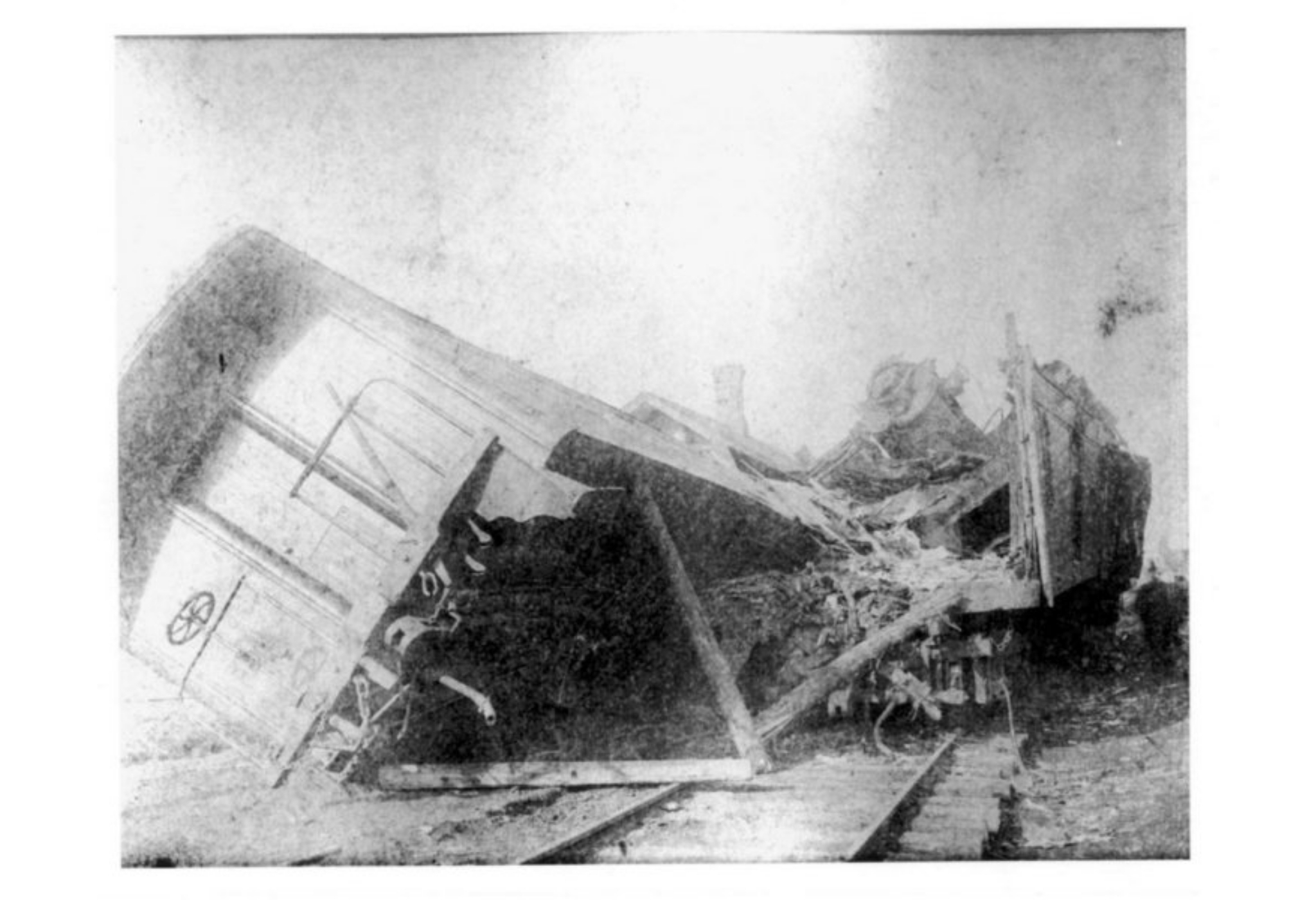 The disaster that inspired the railroad style of watch.
The disaster that inspired the railroad style of watch.
This disaster happened because an engineer’s watch paused for four minutes, which saw him miscalculate the time to the final station – resulting in a collision that killed the engineers of both trains and nine other people.
The railway company hired Cleveland jeweler Webb C. Ball to investigate watch usage on its lines and to make sure the accident would never be repeated.
In 1893, Ball developed the so-called “railroad” watch – a pocket watch that became standard for all railroad operations.
Webb C. Ball still manufactures watches and the railroad style remains popular for its straightforward style and legibility.
What makes a watch a Railroad Watch?
- An open face.
- Accurate to within 30 seconds per week.
- Can operate in temperatures between 34 and 100 degrees Fahrenheit.
- Arabic numerals on a white dial (to make it easy to read).
Men’s Watch Style#3 Dress Watch
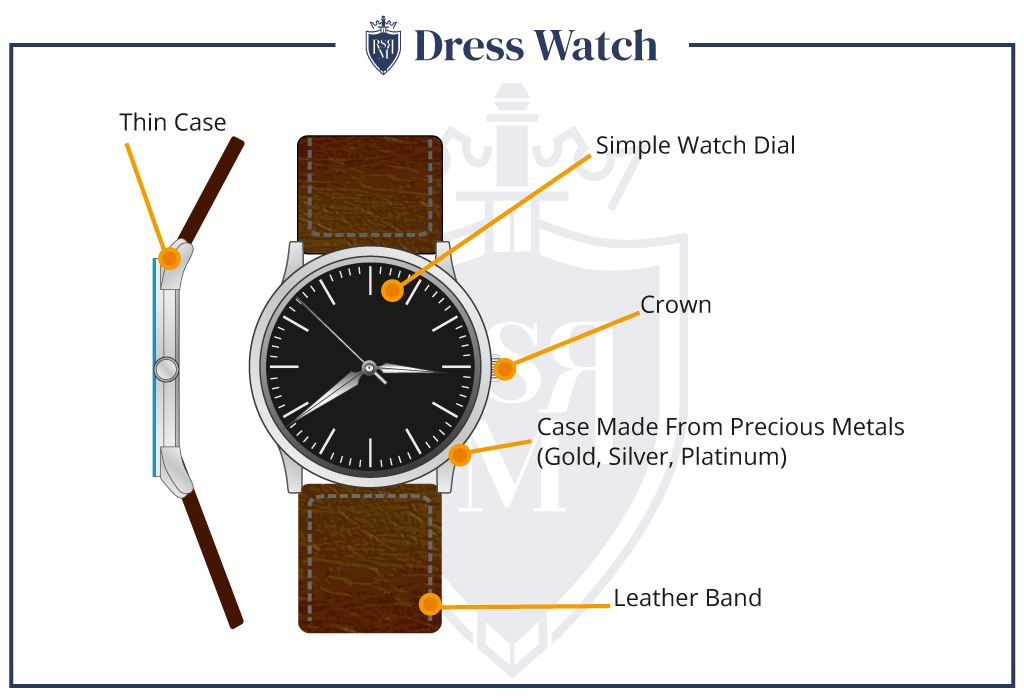 Click here to discover my dress watch guide.
Click here to discover my dress watch guide.
The Dress Watch is the simplest and most elegant watch in our list. Designed to tell the time and nothing else, a dress watch is never ostentatious.
A key feature of the dress watch is its thin casing, which allows a man to slip it under the cuff of a dress shirt with ease.
In the heyday of mechanical watches, bulky models were common because they were easier and cheaper to make. There was more room inside the case to work with. Thin watches were, and still are, proof of superior craftsmanship.
What constitutes a Dress Watch?
- Out of all men’s watch styles, a dress watch’s dial is always the simplest. It has no complications apart from perhaps a date window.
- The face itself is never wider than 42mm and comes in black, white, or silver. Is 42mm too small for a man? Not when it comes to dress watches.
- Even the hour markers are simple – they’re commonly Roman numerals or simple batons.
- Dress watches are made in precious metals like gold to reflect the occasion. It makes sense because wearers purchase them for momentous occasions.
- The straps are always leather – usually darker in color to drive home the formal factor.
- The only decoration allowed on this men’s watch is a single cabochon – a polished gemstone – over the crown.
Men’s Watch Style #4 Field Watch
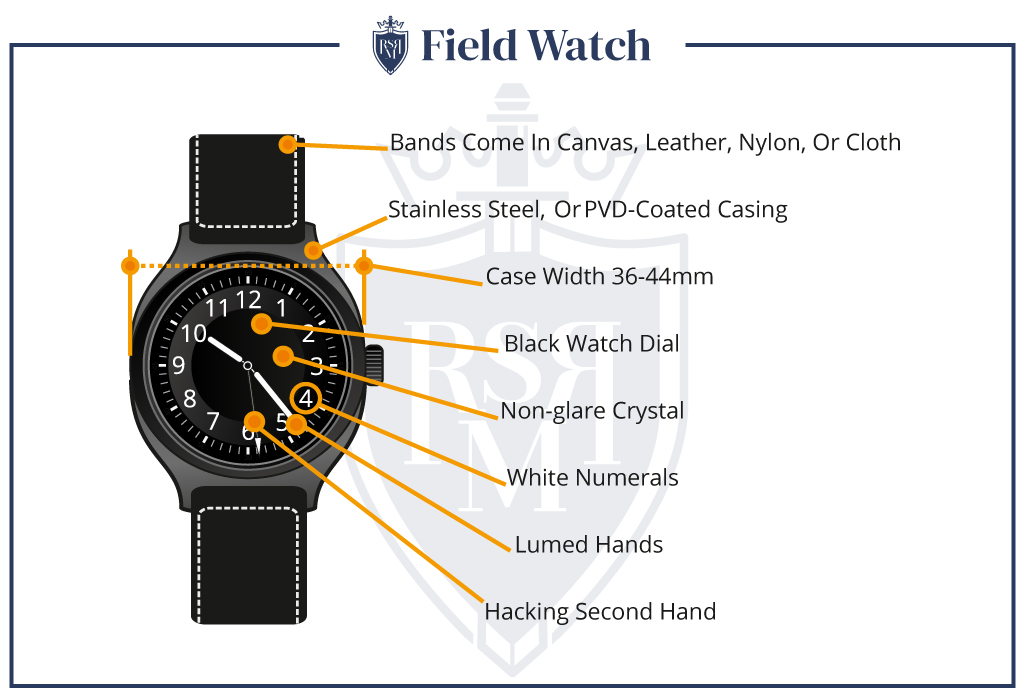 Click here to discover the history of men’s Field Watches.
Click here to discover the history of men’s Field Watches.
This venerable piece has some hardcoremilitary style heritagebehind it.
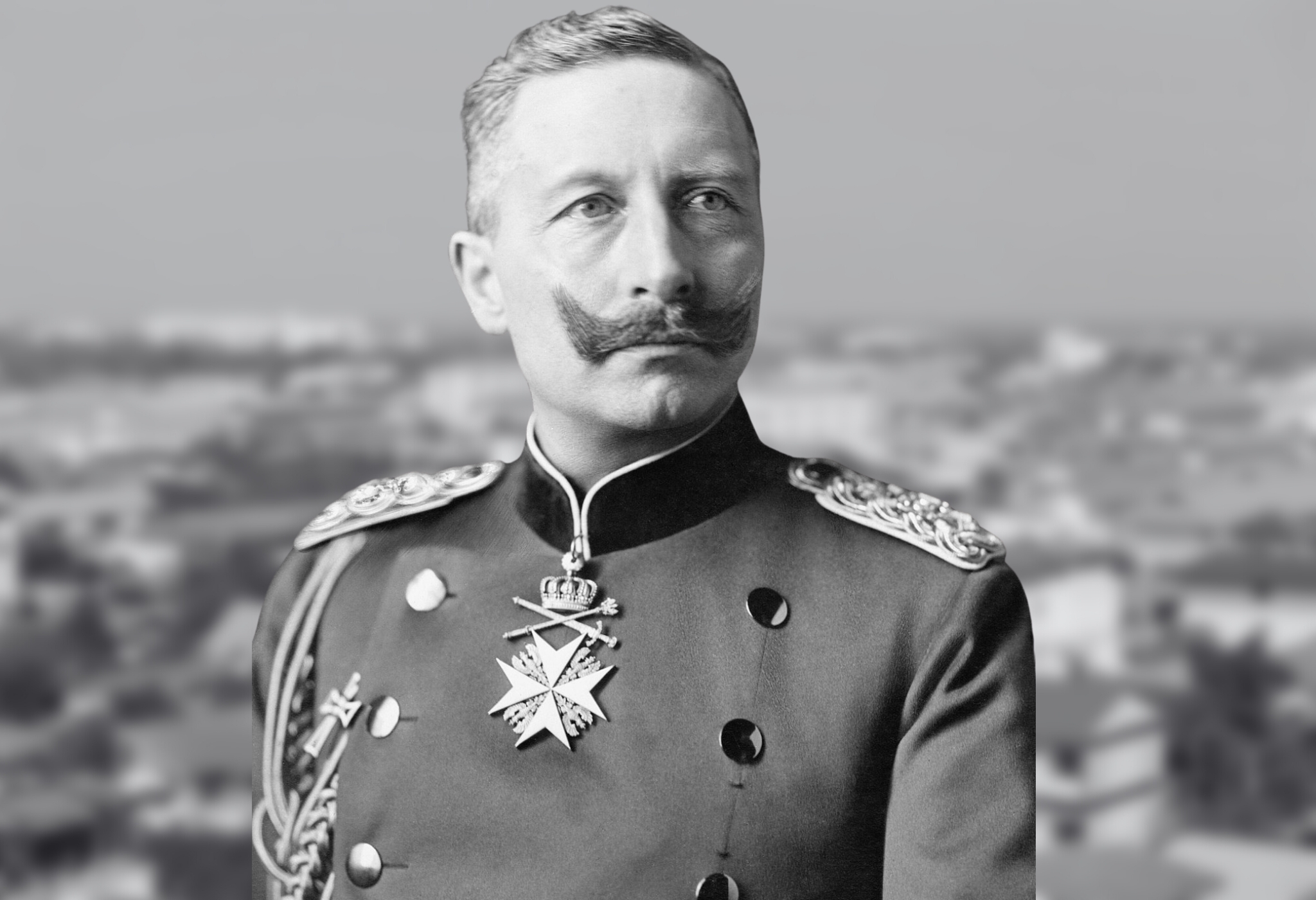 Kaiser Wilhelm I was the first to use the wristwatch as a tool for warfare.
Kaiser Wilhelm I was the first to use the wristwatch as a tool for warfare.
In 1879, German emperor Wilhelm I bought two thousand watches for his naval officers – marking the first time in history where warfare and wristwatches intertwined.
Beforehand, officers used pocket watches – wasting precious seconds to pull them out during battle.
The only problem with Kaiser Wilhelm’s wristwatches? They featured an unseemly grill to protect the glass and this obscured the time.
Field watches grew more popular as precision timekeeping became more important in warfare. They were mass-produced for troops of all countries in World War 2. American GIs found their A-11 field watches to be trusty companions and brought them home after the war. Men’s watch styles have incorporated military-inspired design features ever since.
The A-11 still sets the standard for military watch design to this day.
What makes a watch a Field Watch?
- Glare-proof crystal and high contrast on the numbering render it easy to read in poor lighting conditions.
- Its design is often straightforward, highly legible and durable – exactly what you would expect from something made for war.
- Original designs yielded hand-wound 36mm models, while today’s releases are slightly larger (38-44mm) to suit modern tastes, featuring automatic and quartz movements.
- One unique feature is that the second hand stops when the crown is pulled – perfect for synchronizing your watch with other officers in military operations.
- Bands on men’s field watches are either canvas, nylon, or leather – easily replaced if damaged in wartime.
- Nowadays, you’ll find the body of the watch in stainless steel, titanium, or PVD (Physical Vapor Deposition – a thin, protective coat which is impossible to remove).
Also read:
 ULTIMATE GUIDE To Men’s Hair Types
ULTIMATE GUIDE To Men’s Hair Types Ultimate Guide to Wedding Attire For Men
Ultimate Guide to Wedding Attire For Men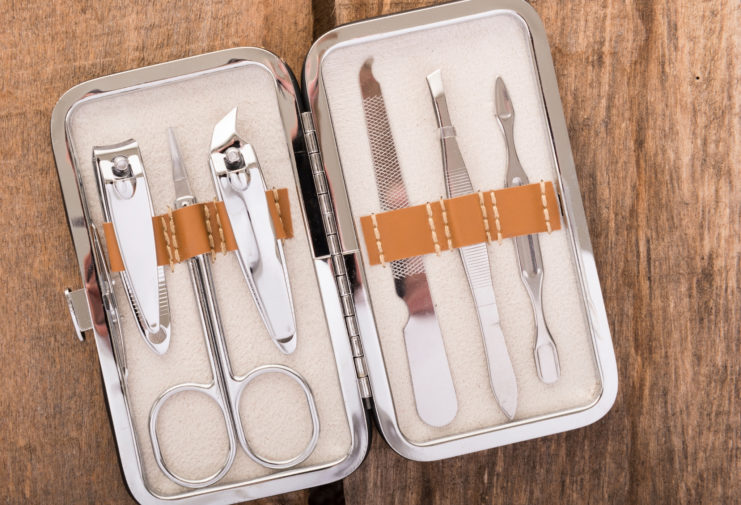 How to Cut Your Nails Properly
How to Cut Your Nails Properly Dressing Sharp and Casual for the Men in Their 30s
Dressing Sharp and Casual for the Men in Their 30s How To Dress For Your Age (20s, 30s, 40s, 50s+)
How To Dress For Your Age (20s, 30s, 40s, 50s+)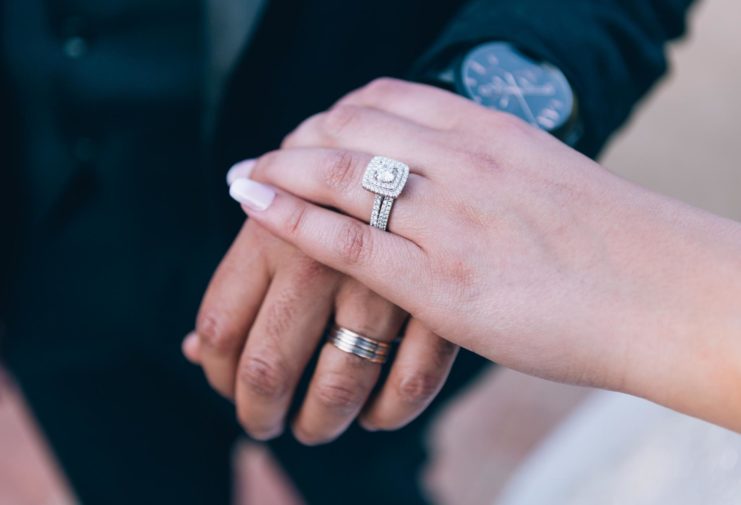 How To Choose An Engagement Ring
How To Choose An Engagement Ring
Men’s Watch Style #5 Aviator Watch
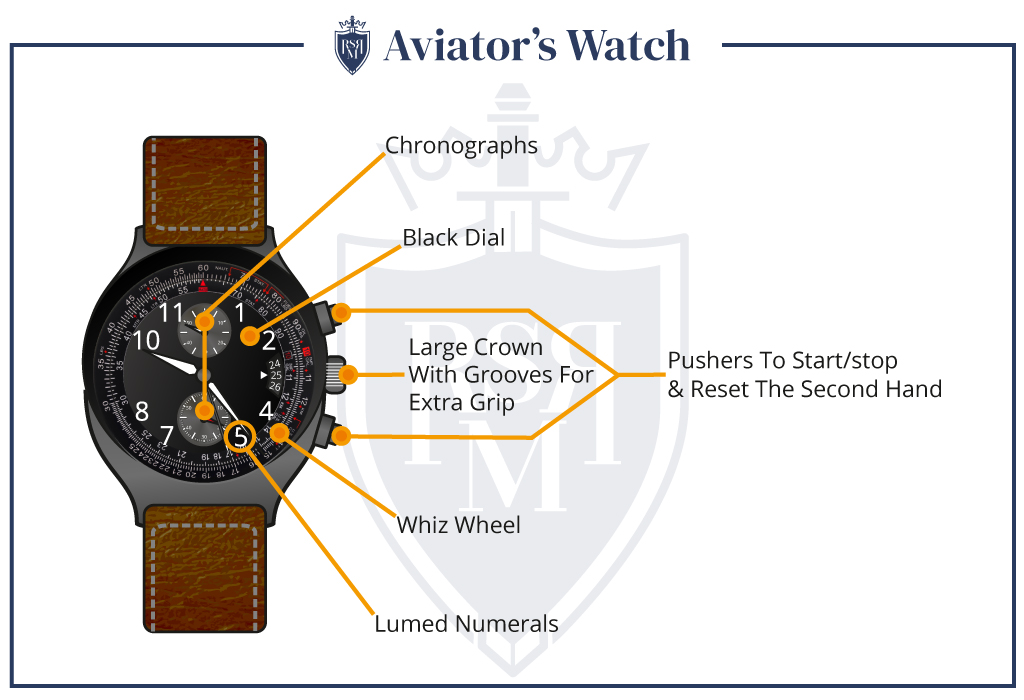 Click here to discover my guide on buying an Aviator Watch.
Click here to discover my guide on buying an Aviator Watch.
This men’s watch started in 1906 on the wrist of adventurous pilot Alberto Santos-Dumont as he achieved the first-ever powered flight in Europe.
Santos-Dumont happened to be friends with Louis Cartier (recognize the name?) and asked him to develop a watch that could act as a stopwatch in addition to telling time.
The result was a piece that featured Roman numerals and a curved dial within a rectangular case.
As aviation evolved, so did the watches. Later designs included extra-large cases and dials for easy reading at a glance plus large white Arabic numerals on black enamel dials for contrast. They were also fitted with chunky, onion-shaped crowns that were easy to grip when wearing thick gloves.
Long straps made these watches easy to fit over a flight jacket, allowing the pilot to stay fully protected.
In short, these watches were made as resilient as the pilots themselves.
What makes an Aviator Watch?
- Men’s aviator watches feature high-contrast dials and numerals for telling the time at a glance.
- A larger crown is also common as it allows for the pilot to adjust the time without needing to remove his gloves.
- A tell-tale sign of an Aviator Watch is whether or not it has extra features for added practicality. It might come with a chronograph (originally used for timing a plane’s turns). Also look out for time zone functions and “Whiz Wheels”: a tool capable of calculating time, fuel, and distance.
Men’s Watch Style #6 Dive Watch
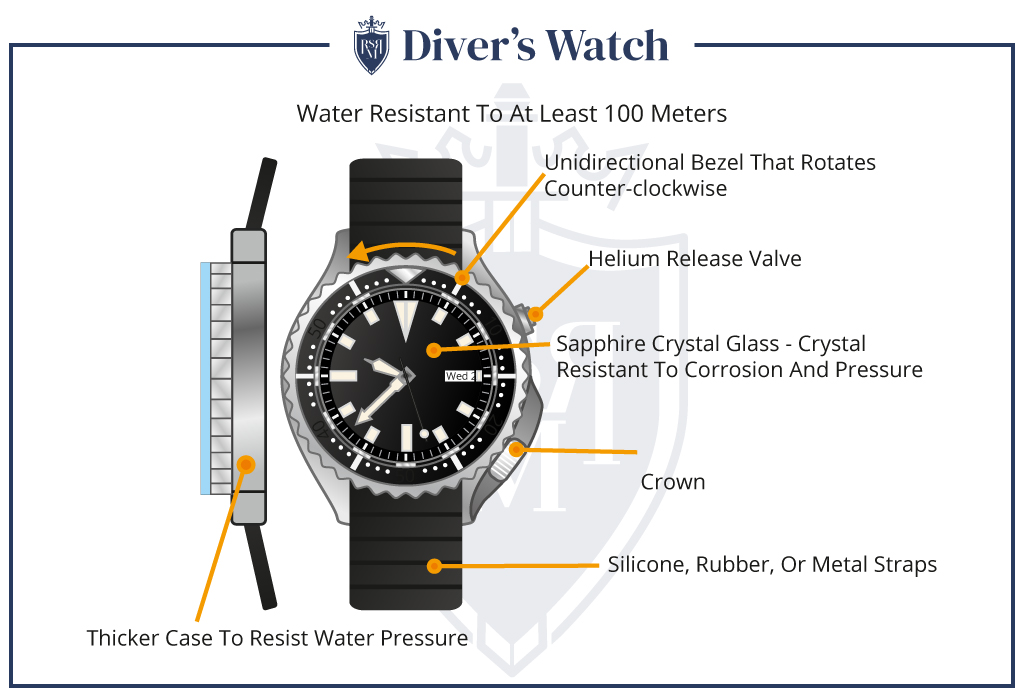 Click here to discover more about the Dive Watch.
Click here to discover more about the Dive Watch.
The name says it all – this watch is used for underwater diving and to monitor dive times.
The first recorded use of a dive watch was in 1926 when Rolex registered a patent for the water-resistant ‘Oyster’ watch case.
Men’s watch styles at this time leaned towards thin, elegant and fragile models. The Oyster proved it was different. Rolex arranged for daring swimmer Mercedes Gleitze to embark on a daunting 10-hour swim across the British Channel with the Rolex Oyster hung around her neck. Not only did Mercedes successfully cross the channel but the watch remained intact and dry inside – it kept perfect time throughout!
Today, the diver’s watch is constructed to withstand high water pressure. Domed sapphire or mineral glass is used for this as they are durable and scratch-resistant as well.
These watches feature a rotating bezel so divers can time dives and monitor their air supply. The bezel is often unidirectional, only able to be rotated anticlockwise, to prevent the bezel from being fatally adjusted to tell a diver they have more air remaining than they really do.
Dive watches are typically water-resistant to 660-980 feet. Higher-quality dive watches can go even deeper. They come fitted with a helium release valve to mitigate pressure build-up.
Dive watches are so important they’re regulated by the International Organization for Standardization.
What are the essential parts of a Dive Watch?
- Dive watches are made with stainless steel – the best material for braving the pressures of the deep and the corrosiveness of salt water.
- Due to the sheer hardware that goes into them, the watches are usually larger than others.
- They use thicker crystals in order to enhance pressure resistance. The crystals can come in acrylic, hardened glass, or synthetic sapphire.
- Easy legibility is a must, so these men’s watches are designed with as little clutter on the dials as possible. The minute hand is deliberately made larger.
- In addition to that, the markers for 3,6,9 and 12 are designed as conspicuously as possible to prevent disorientation-induced readout errors. The same goes for the zero-marker on the bezel.
- The size of the case makes it easy for divers to rotate the bezel, even when wearing a wetsuit.
Men’s Watch Style #7 Racing Watch
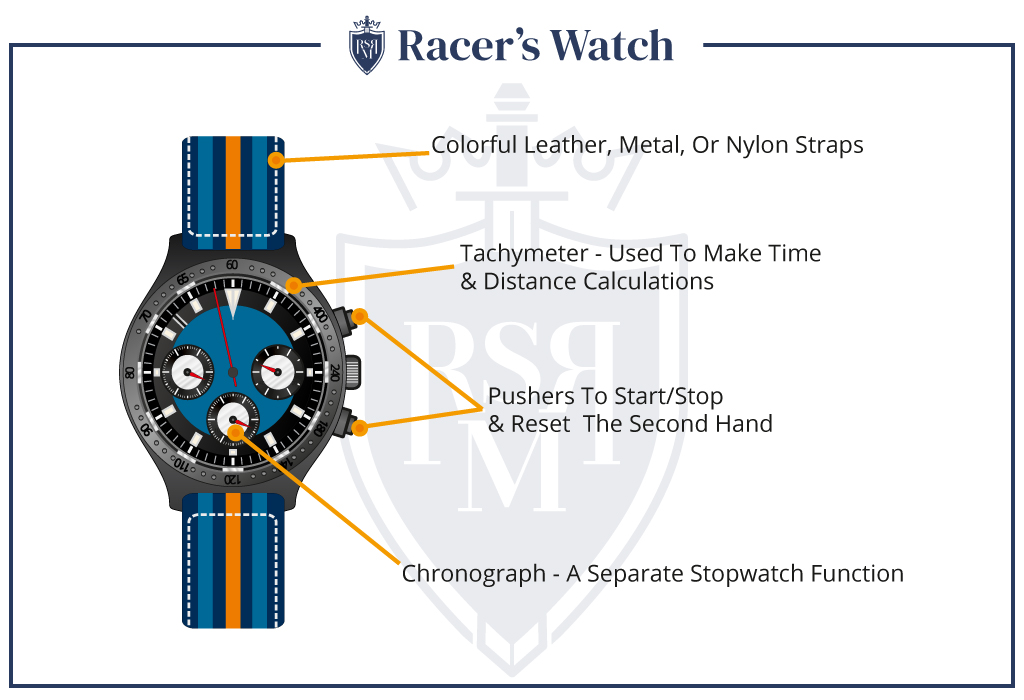 Click here to discover my guide on Racing Watches.
Click here to discover my guide on Racing Watches.
The racing watch was designed for – you guessed it – racecar drivers. They come packed with attitude and can be found in an array of bright colors. Personality extends to accessories with strap options including decorated and punched leather or fabric bands.
When Steve McQueen starred in Le Mans, a movie based on the iconic 24-hour Le Mans Endurance Race, he chose to wear the Heuer Monaco by Swiss Heuer: a square-shaped, red, white and blue chronograph.
The rest is history.
What is a Racing Watch?
- Two signature aspects of the racing watch are the chronograph and the tachymeter.
- What is a chronograph watch? They act like a stopwatch. Pushers at the 2 and 4 o’clock positions start and stop it with sub-dials marking elapsed minutes and hours.
- Tachymeters let the wearer calculate the speed of a car, racehorse or anything else they desire. By measuring the seconds it takes to cover a set distance, the outer markings show the speed in miles or kilometers per hour.
- Racing watches are loud by definition and meant to draw attention. High contrast dials ensure they can be read at high speeds.
- Racing watches come with metal bracelets as standard these days. Traditionally though, they sported leather or rubber straps that were perforated for breathability.
Men’s Watch Style #8 Digital Watch
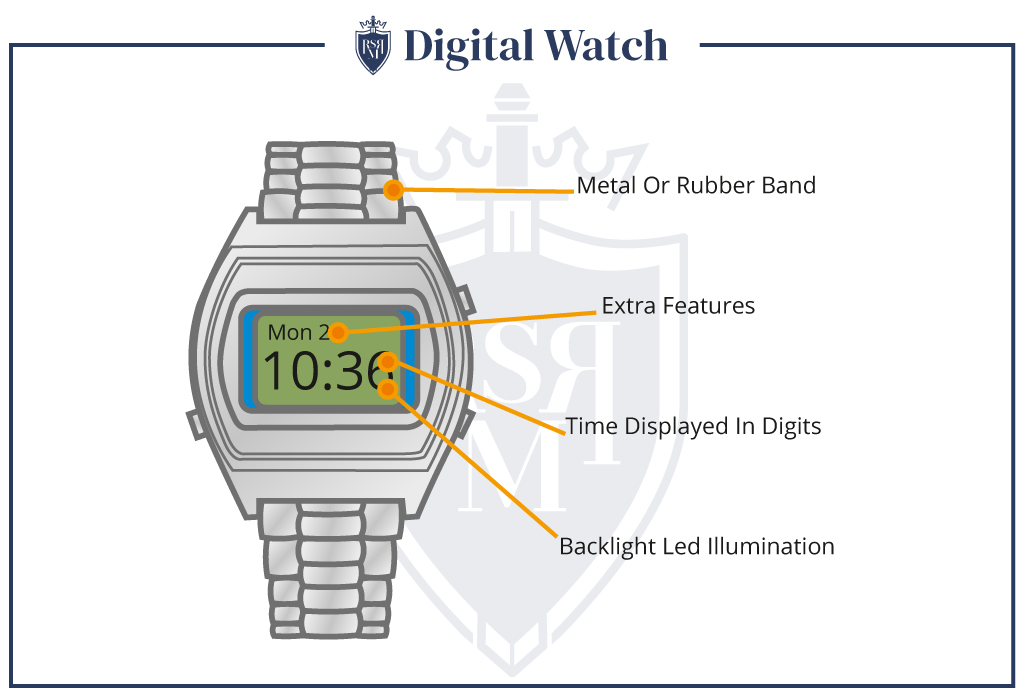 Click here to discover which digital watches are in my personal collection.
Click here to discover which digital watches are in my personal collection.
Riding the coattails of Seiko’s quartz watches, the Pennsylvania-based Hamilton Watch Co. released the first digital timepiece – the Pulsar – in 1972 with a price tag of $2,100.
The first models had a gold case and initially used LED lights to tell the time digitally. This drained the battery too quickly to be efficient with the introduction of LCDs (Liquid Crystal Displays) by Seiko the following year allowing watches to run all day.
Features of a Digital Watch
- Time is indicated by digits rather than hands on a dial.
- Digital Watches tend to feature a fluorescent background so you can check it when it’s dark. They’re a popular choice in sports because of the precision they offer.
- They’re often the least expensive – running as low as $5 in some cases.
Men’s Watch Style #9 Smart Watch
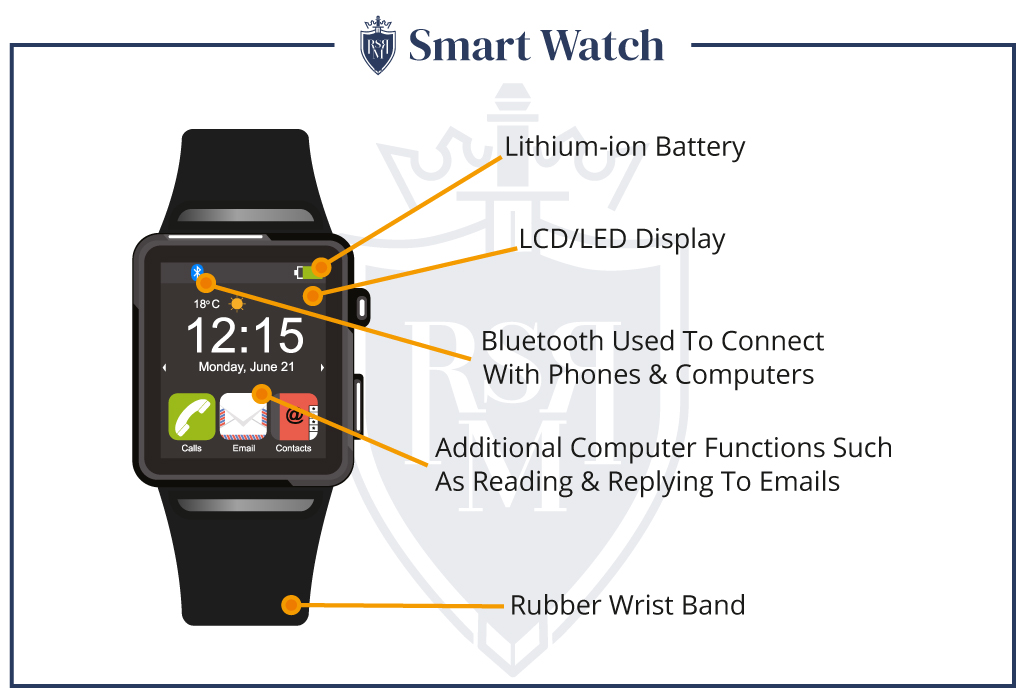 Are Smartwatches stylish? Click here to find out.
Are Smartwatches stylish? Click here to find out.
A smartwatch is one of the most modern men’s watch styles and essentially a wearable computer. These might seem like a recent addition to a man’s wrist but they have history.
In 1927 the Plus Four Route Indicator was the first watch to have ‘mapping technology’. It was a wrist-sized, scrollable map that the user wound manually as he progressed along the route. This might not be ‘smart’ in the modern sense of the word but is definitely an intelligent use of wrist space!
The first true smartwatch was the Data 2000 launched in 1983. It came with an external keyboard for data entry and had a 2,000-character capacity.
15 years later in 1998, Steve Mann developed the first Linux smartwatch and was rightly hailed the ‘father of wearable computing.’
Today, smartwatches include GPS functionality, heart rate monitors and much more. Some smartwatches have become an extension of the wearer’s smartphone, handing off calls and updating health information.
Smartwatches continue to – and will always – evolve as technology evolves with them.
How would you define a Smartwatch?
- A huge range of technological features such as Bluetooth functionality to connect to computers and cellphones.
- Cellphone compatibility – to read SMS messages and emails.
- Backlit LCD/OLED screen.
- Rubber, metal or fabric band depending on the brand.
Men’s Watch Style #10 Fashion Watch
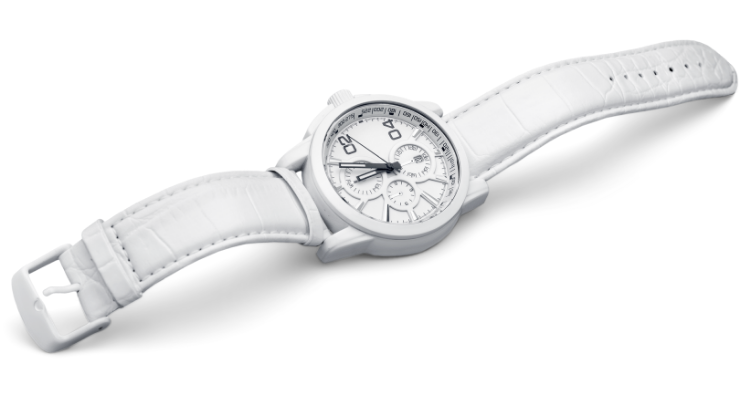
The Fashion Watch revolution began in 1983 when Swatch started manufacturing watches that followed NONE of the above standards.
It wasn’t long before Fossil and Guess jumped on – the fashion watch thus came into prominence in the 1990s and 1980s.
In general, a fashion watch is produced by manufacturers that don’t necessarily specialize in watchmaking. Fossil for instance produces wallets and bags in addition to various men’s watch styles.
What makes a watch a Fashion Watch?
This style of men’s watch reflects current fashion trends. They act as a means of personal expression for the wearer. Anything goes with fashion watches, and this allows for maximum creativity for the manufacturer.
In general, fashion watches are more affordable. Brands typically utilize cheaper manufacturing materials.
Their affordability made the ‘wardrobe watch’ phenomenon possible for the first time. The average man could buy several and have a watch that can be worn with every outfit – something that wasn’t possible before then.
Despite the seemingly infinite combinations of colors and features, fashion watches typically showcase an oversized crown, bright colors, and printed watch faces.
I hope this article opened your eyes to many men’s watch styles out there. There’s a watch for every occasion and situation – no matter what your style is and whether you’re flying a plane or wearing a tux.
Click below to watch the video – 5 Watch Styles Every Man Should Know
Also read:
 ULTIMATE GUIDE To Men’s Hair Types
ULTIMATE GUIDE To Men’s Hair Types Ultimate Guide to Wedding Attire For Men
Ultimate Guide to Wedding Attire For Men How to Cut Your Nails Properly
How to Cut Your Nails Properly Dressing Sharp and Casual for the Men in Their 30s
Dressing Sharp and Casual for the Men in Their 30s How To Dress For Your Age (20s, 30s, 40s, 50s+)
How To Dress For Your Age (20s, 30s, 40s, 50s+) How To Choose An Engagement Ring
How To Choose An Engagement Ring